Jump Ahead To:
KAYAK TROLLING MOTOR BASICS: INTRO
Before you read up on the kayak trolling motor basics, we would suggest that you take some time to visit our Kayak Trolling Motor Ultimate Guide, where the KFC team has written an all encompassing article on all topics related to kayak trolling motors, with an eye towards kayak fishing of course.
KayakFishingCorner.com has devoted a number of kayak fishing seasons to the evaluation of the various types of kayak trolling motors available for purchase by the general public. We’ve even ranked The 5 Best Kayak Trolling Motors!
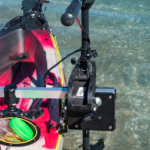
Overview
First, as an Amazon Associate, I earn from qualifying purchases.
KFC has written this post to include all of the important details that you need to know to have a solid understanding of kayak trolling motor basics. We have organized this post to include a number of separate categories in hopes of providing a reader friendly experience.
First, we have included a brief section discussing the basics of the kayak trolling motor. Next, we’ve included a short “how to” checklist that will aide you in your efforts to use a kayak trolling motor properly. Then, we’ve added a section that explains a number of the different features that you should look for in a kayak trolling motor. After that, we have included a section with a link to one of our favorite kayak trolling motors where you can visit its product page to learn more details. Finally, we’ve included a brief section detailing our own experience with a kayak trolling motor!
Parts of a Kayak Trolling Motor
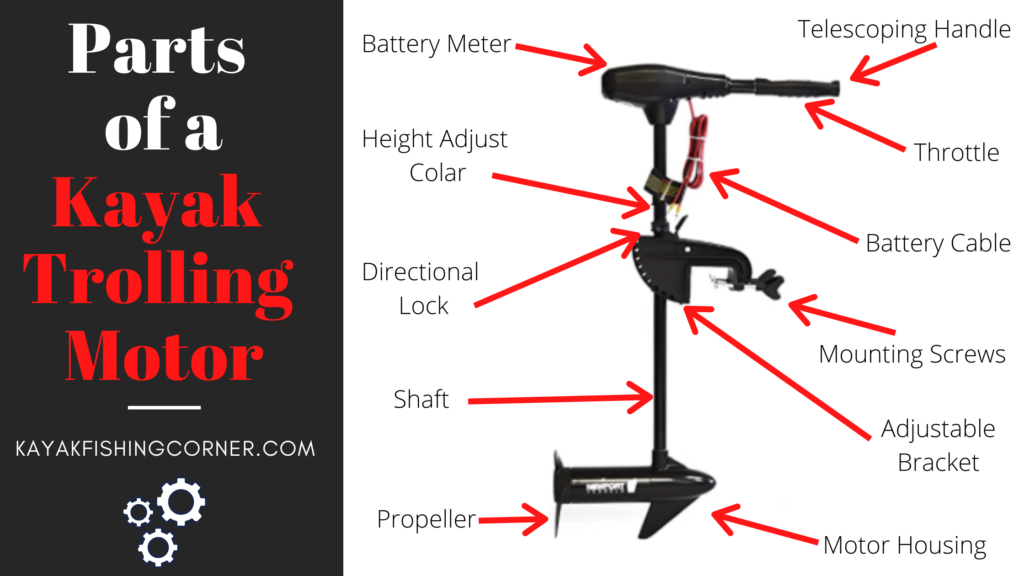
Kayak Trolling Motor Basics
Please note: This post contains affiliate links. An affiliate link means that we may earn advertising/referral fees if you make a purchase through our links.
Shortcut to Kayak Trolling Motor Review
What we’ve discovered during the course of our many season’s worth of evaluation on the kayak trolling motor is very interesting. KFC’s research has led it to conclude that during the last five years, because of the quickly expanding popularity of kayak fishing, kayak trolling motors are becoming more and more available to the kayak fishing community. Greater availability, of course, means increased affordability.
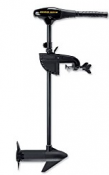
KFC wanted to write this particular post on the kayak trolling motor basics after countless KFC readers wrote in to us requesting that we write an introductory type article to explain this kayak fishing product at an elementary level. We think these requests followed the readers having seen several kayak trolling motor products highlighted by KayakFishingCorner.com in this kayak fishing community.
We thought this was a perfectly reasonable request and made a lot of sense for a kayak fishing community website. We commenced efforts by deciding to collect and review of all sorts of kayak trolling motor product reviews, feedback, specifications, capabilities, qualities and other information that we could find. We were looking for recurring questions or other areas of ambiguity. We wanted to know which “basics” were being left out of the information already available about the kayak trolling motor basics.
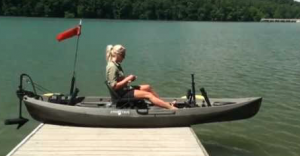
Without an understanding of the kayak trolling motor basics, a kayak fisherman will be likely to make an errant purchase, whether as it relates to the kayak trolling motor itself, the fishing kayak to which it attaches, or as to one of the hundreds of pieces of kayak fishing gear that are associated with the kayak trolling motor. There are a number of things you have to get “right”, and without a solid foundation on the kayak trolling motor basis, your chances of doing so are slim to none. This KFC article will provide you with the baseline kayak trolling motor knowledge that you need!
There are hundreds of kayak trolling motors on the market today. We think the skyrocketing popularity of kayak fishing is causing more and more kayak trolling motors to come onto on the market each day. Some of these “new” kayak trolling motors are quite appealing. Others look like they could fall apart at any moment, leaving you stranded in a tricky situation.
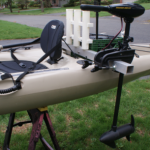
Before we get into the particulars, or the kayak trolling motor basics if you will, let’s put a definition to the word “trolling”. Trolling isn’t a word common to many vocabularies, and its a term that we’ve found even the most experienced of kayak fishermen are unable to define.
Trolling is officially defined as, “[to] fish by trailing a baited line along behind a boat. The kayak trolling motor doesn’t have to be used solely for this type of kayak fishing. In fact, often times it is often used as a source of power for transportation to distances that would simply be too far to paddle. In a sense, the trolling motor “trolls” behind the fishing kayak just like the fishing line would in the true definition of the world “trolling”.
How to Use a Trolling Motor
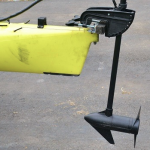
- First, you’ll need to securely attach the kayak trolling motor to the hull of your fishing kayak. This is accomplished by using a trolling motor mount. The mount usually comes with all required mounting hardware.
- We suggest that you place the trolling motor’s throttle or handle towards the rear of the kayak. We like putting it near our dominant arm, ensuring prompt access to control our direction and speed.
- After these steps, you’ll need to connect the kayak trolling motor to the trolling motor battery. This battery, of course, is used to provide power to the unit.
- Please be certain to keep all wires and any cables safely located away from high traffic areas or locations where they might snag. KFC usually runs our cables underneath the top of the kayak’s hull.
- Ok, here comes the fun part! Once you get the kayak to the water, gently twist the throttle. This action will make the propeller turn. Make sure to do this slowly at first!
- Ensure that the propeller turns clockwise and counter clockwise, as this is required for forward and reverse movement. You won’t want to venture away from the shoreline until you’ve run this check!
- Check to make sure that the kayak trolling motor mount isn’t sliding or twisting when the propeller is provided power. If you have poorly attached the trolling motor, it is possible that the unit could come loose from the mount. Not good!
- Next, confirm that the shaft of the kayak trolling motor isn’t flexing too far when power is supplied. Most trolling motor shafts are quite rigid, and assuming that you’ve purchased a high quality motor, you should be just fine! You’ll also need to check the shaft’s length to make sure the shaft isn’t too deep for the waters that you intend to kayak fish.
- Take it from someone who has been stranded on the water with a dead battery! Always remember to be mindful to watch your supply of battery power. You can check the levels by using the gauge located on your battery or the trolling motor’s display.
- Keep enough charge to make it all the way back to shore after you’ve finished your kayak fishing trip!
Important Features
- Sturdy Connection.
If you look at the example kayak trolling motor shown below, you can see a clamp style attachment device. This allows for the kayak trolling motor to be attached to an endless number of fishing kayaks, as it simply slides onto the kayak trolling motor mount and is tightened to an appropriate level. Thats it!
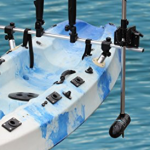
The image below shows a close up of what a traditional kayak trolling motor mount and the attachment clamp on the kayak trolling motor itself look like. yes, designs to vary to some degree, but most kayak trolling motors will generally follow the design of the below:
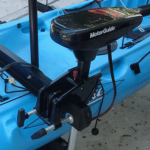
- Powerful Motor. It should come as no surprise that knowledge of the motor itself is one of the most important kayak trolling motor basics. Kayak trolling motors come in a number of different sizes, styes, and pounds of thrust. What was the last part you say? Pounds of thrust? Yes. Commonly referred to as simply “Pound Thrust”. Let’s learn what that means.
Thrust is generally measured in pounds (in the United States, that is). Wait, what is thrust? Thrust can be defined as “to push something with force”. Think about it, that’s exactly what the kayak trolling motor is doing. Makes sense, right? On to the next step. A “pound of thrust” is the amount of force needed to accelerate 1 pound of material 32 feet per second, per second. More of a visual person? Me too. Let’s stick to pictures:
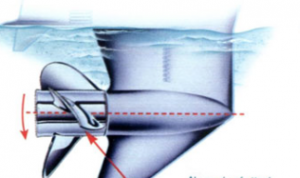
- Length of Shaft. Every kayak trolling motor is going to have a motor connected to a propeller. The motor (when under power) causes the propeller to turn, creating thrust, and driving the fishing kayak forward.
Many kayak trolling motors are equipped with a 30″ – 50″ long shaft, which is the long piece of material (usually metal, carbon fiber, or fiber glass) connecting the propeller to the handle. Many come with several speeds, most allowing for forward movement, but some allowing for reverse (which is very important for kayak fishing).
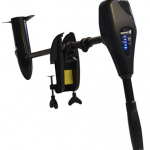
High end models even come with LED style battery meters (important for battery life monitoring) and telescoping handles (important for adjusting the kayak trolling motor to the height and comfort level of the kayak fisherman.
- Dependable Battery. You wouldn’t get very far with your kayak trolling motor if you didn’t have it connected to a power source. This is the final piece of kayak trolling motor basics. These batteries can last a long time, surely long enough for the average kayak fishing outing. But how long to be exact?
To figure out how long the kayak trolling motor battery will run your kayak trolling motor, simply divide your amperage hours by the draw of the motor. In other words, if you’re battery is measured at 100 amperage hours and the draw of the motor is 25 amps, you will have approximately 4 hours of consistent use.
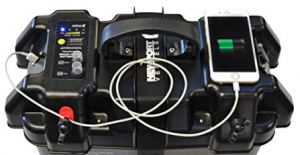
Kayak trolling motor batteries have come along way in terms of ergonomics in the last several years. Most are built with thick rubber padding on the bottom to prevent the battery from sliding around in the fishing kayak. Some, as you can see above, even come with direct USB connection and accessory port, allowing for one USB charger and one 12V accessory port so that you can connect various DC accessories while you are out on the water. Music anyone? The ability to charge your phone while on the water is also an important safety feature and strong consideration should be put into kayak trolling motor batteries that include this feature.
Kayak Trolling Motor Basics: Buy the Best Kayak Trolling Motor
(Commissions Earned)
This kayak trolling motor is capable of delivering complete directional control with its forward and backward motion capabilities. Its freshwater and saltwater suitabilities are great examples of the dual use we love to find in our product recommendations! These two features combine to make this the perfect trolling motor for kayak fishing!
We should mention, it is also the durability of this kayak trolling motor model that has won it our recommendation. The trolling motor withstands the coldest months of an Oklahoma winter. It has not failed during some of the hottest summer days. This is a kayak trolling motor that you can rely upon for many seasons to come. But, what good is the trolling motor without a reliable battery box, well…
Kayak Trolling Motor Basics: Best Kayak Trolling Motor Battery Box
(Commissions Earned)
A Great Option for Fishing Kayaks!
This model is a 17″ by 12″ by 10″ battery box, complete with a built in battery meter. The meter is constructed as an LED notification system. It is capable of measuring your kayak trolling motor battery’s charge with just the push of a button! Not impressed? Well, what if we told you that it also comes with a plug in USB charger and accessory port! You can see the port in the image above. The ability to charge your phone while on the water is great!
This specific battery box keeps your kayak trolling motor battery safe from exterior impact and water. It has a rubberized “no slip” footing. It will not slide around while the fishing kayak is moving along rough seas or choppy waters!
My Experience
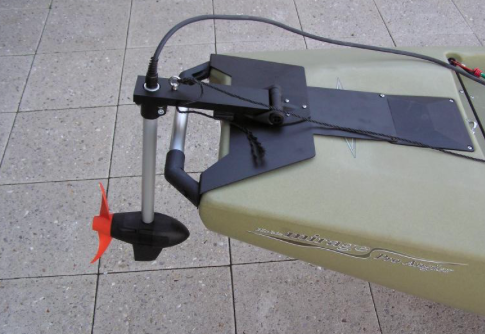
I first heard about kayak trolling motors about three years ago while I was kayak fishing on Lake Travis in Austin, Texas. My friend and I had ventured out onto the water, and we had immediately seen a fellow kayak fisherman struggling in the distance. He was looking in our direction and looked to be frantically waiving a burnt orange colored flag at us. He was clearly in distress, so we traveled over to him.
Before we could get to him, another kayak fisherman was able to reach him. This good samaritan was assisted by the power afforded to him by the kayak trolling motor, and we were amazed how quickly and smoothly the good samaritan was able to make it across the water. When we also arrived to offer our assistance, we quickly learned that it wasn’t an orange flag but a University of Texas shirt that the stranded individual had been waving.

What was also clear is that the stranded fisherman had consumed far too many Mike’s Hard Lemonades, or so he said. He claimed to have consumed at least 9, and the evidence was in the hull of his fishing kayak. He slurred an explanation centered around how he lost his kayak paddle. He didn’t take kindly to my suggestion that he look into a Kayak Paddle Leash.
Long story short, the good samaritan was able to safely tow the intoxicated Texas fan back to shore, where we soon witnessed him struggle up to his RV and take a seat at his lawn chair. My friend and I were very impressed with the quick and smooth maneuverability of the good samaritans fishing kayak, and knew we must look into the kayak trolling motor basics to see if one of these trolling motors might be of use for our own kayak fishing experiences!
KAYAK TROLLING MOTOR BASICS: SCORES
Quality – 4.5/5
As a general rule, kayak trolling motors are one of the higher quality pieces of kayak fishing gear on the market. Why? Because trolling motors have been around for many, many years. Most trolling motors can be used for boats of any kind, whether kayaks or some other kind of boat. Over time, the low quality manufacturers have faded away, leaving only those who put forth a quality product still in the picture!
Performance – 4.75/5
We have owned a kayak trolling motor for many seasons. It is undoubtedly the single best investment we have made in terms of having an immediate impact upon our performance as kayak fishermen. Why? Because it allows us to navigate more efficiently on the water, but that’s not all. Its also great for helping ward off the fatigue that comes with having to paddle from place to place. This, of course, allows us to stay on the water for longer periods of time, with the result being more fish caught!
Price – 4/5
Ok, this is one score where a trolling motor is going to suffer, but not too much. Simply put, kayak trolling motors are not cheap (but you don’t want them to be). Typically, you can find a trolling motor for between $150 and $450. The wide variability in price is associated with the size of the motor you get (measured in cubic centimeters) and your source. Big box retailers are going to be a little more expensive than what you can find online, at least in our experience. Don’t try to save a few bucks by buying a lower quality model. The last thing you want to have happen is for your trolling motor to break down on you when you are far from shore. Buy it once, buy it right the first time!
Durability – 4.5/5
Again, we’ve had our kayak trolling motor for many seasons now. It performs today just like it did when we first installed it. You’ll want to be sure to properly maintain it (most come with a user’s guide that tells you all the steps you need to take). Also, when you aren’t using the trolling motor, we suggest removing it from your kayak and storing it in a temperature controlled area somewhere away from direct sunlight. As with any piece of mechanical equipment, exposure to wide temperature swings and direct sunlight could have negative impacts on longevity and durability.
Overall – 4.4/5
With an average score in excess of 4.4 out of a possible 5 points, KFC thinks very highly of the kayak trolling motor that we’ve linked to above. It is of the quality that we require to be featured on KFC, makes an immediate impact on your performance on the water, is reasonably affordable, and will last you year after year. Remember, even though installing the trolling motor can take some time (it took us about 30 minutes – and we used the user’s guide every step of the way), the end result is well worth it! We would suggest that you consider buying a trolling motor for yourself. Be sure to let us know what you think!
KAYAK TROLLING MOTOR BASICS: SUMMARY
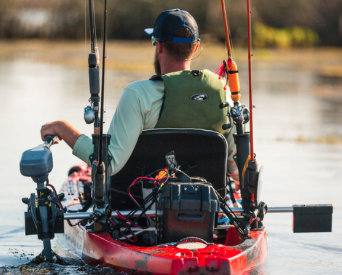
I hope this article has helped you learn more about the kayak trolling motor basics. Remember, if you have any questions about the kayak trolling motor basics, please comment near the bottom of this page. We love to engage with the kayak fishing community. We strive to be a free and interactive resource for kayak fisherman of all levels of experience!
Look at the image above. Does this kayak fisherman look like he is struggling to get from one fishing hole to the next? I don’t think so. Sometimes it is nice to put away the paddles and allow for the smooth and efficient kayak trolling motor to take you from Point A to Point B. Remember, fish can swim a lot more quickly than you can paddle your kayak by hand.
Why not level the playing field with a kayak trolling motor? When you decide to go back to the paddling method, you can simply lift the kayak trolling motor up and out of the way. Sounds like a kayak fishing accessory with no downside to me! Hopefully, with your new knowledge of the kayak trolling motor basics, you will consider buying one for yourself! Looking for a great way to get your fishing kayak to the water? KFC has discovered the Best Kayak Cart. Planning to use your kayak trolling motor on your fishing kayak? Make sure you have chosen a Kayak Cart for Kayak Fishing so that you have a complete set of kayak fishing gear! Learn more about how these awesome pieces of kayak fishing gear work!
Ever considered attending or competing in a kayak fishing tournament? These type of events are a great way to meet new friends and become a better angler! Find out more, here!
Comments
Do you have any questions about the kayak trolling motor basics you’ve read about above? What about questions on kayak fishing in general? Please share with the rest of the KayakFishingCorner community by posting in the Comments section below.

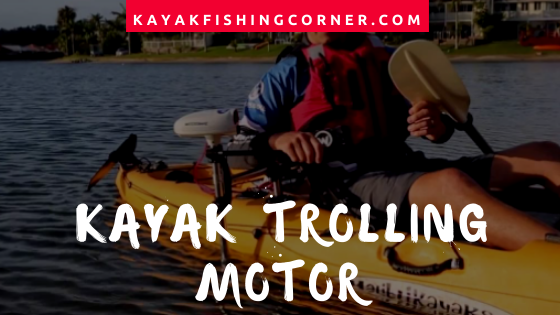


This looks like a good idea. I’m no good at steering my kayak with my paddles. A directional trolling motor looks like a way better choice for me!
Jimbo,
You’re not alone. A trolling motor is great for helping you keep a straight course, especially if the currents are strong! We’re glad you found this article so helpful!